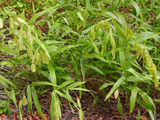Native Plants

Q. Who is Mr. Smarty Plants?
A: There are those who suspect Wildflower Center volunteers are the culpable and capable culprits. Yet, others think staff members play some, albeit small, role. You can torture us with your plant questions, but we will never reveal the Green Guru's secret identity.
Did you know you can access the Native Plant Information Network with your web-enabled smartphone?
Ask Mr. Smarty Plants is a free service provided by the staff and volunteers at the Lady Bird Johnson Wildflower Center.

rate this answer
Monday - June 18, 2012
From: Leander, TX
Region: Southwest
Topic: Xeriscapes, Drought Tolerant, Groundcovers, Shade Tolerant, Grasses or Grass-like, Herbs/Forbs
Title: Ground cover under live oaks
Answered by: Guy Thompson
QUESTION:
I have some areas under Live Oak trees (maybe 200 sq. ft.)that remain bare, in spite of trying Habiturf. Soil is dry, poor and shallow. Can you suggest a living ground cover that would not require major rework of the soil?ANSWER:
I have had the same experience as you, except my bare ground is under deciduous oaks, Quercus texana (Nuttall oak). I am experimenting with several native plants that will survive drought. I'm having pretty good luck with Calyptocarpus vialis (Straggler daisy), Carex planostachys (Cedar sedge), Salvia lyrata (Lyreleaf sage), and Paspalum setaceum (Thin paspalum). Some of the other sedges, such as Carex texensis (Texas sedge) and Carex amphibola (Creek sedge) might do well, although they might need slightly more water than Habiturf. These are all mowable at a height of about four inches. The first four species are common around suburban Central Texas, and I simply transplanted some from other spots in my yard. I also tried Tridens muticus (Slim tridens), but it seems too coarse for a lawn. If a taller grass will fit in, try Chasmanthium latifolium (Inland sea oats), which grows to about two feet in height and does very well in shade.
Images of some of my suggested species are shown below.
From the Image Gallery
More Xeriscapes Questions
Non-native hylocereus undatus for Austin
February 24, 2012 - Can we plant Hylocereus (Dragon Fruit) here in Austin, TX? We are going to have a large xeriscape bed and want to know what all we can put in it. We are new to Texas so we have no clue what grows here...
view the full question and answer
Appropriate use of redbud from Austin
May 04, 2014 - I am considering purchasing a hearts of gold redbud; I
am also xeriscaping my front yard. I live in Austin,TX.
Will this tree do ok in full Tx sun (8+ hours) with once a week watering?
If this...
view the full question and answer
Groundcover for Boston MA
March 12, 2013 - We have a small back yard that gets great sun in spring before the leaves are fully back on the tall trees surrounding the perimeter, and then a lot of shade in summer. We have weird patchy grass and ...
view the full question and answer
Foundation plants for Albuquerque.
July 01, 2012 - Hello,
I live in Albuquerque. I am looking for some native/xeric low water usage plants for foundation plants for my home.
They will be foundation plants for a two story home that has a large ponde...
view the full question and answer
Low-maintenance native plants for Arizona
March 12, 2009 - Will you please suggest some Native plants that can be left without care for the summer and survive - other than cactus?
view the full question and answer
| Support the Wildflower Center by Donating Online or Becoming a Member today. |

